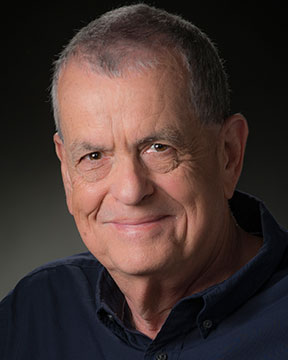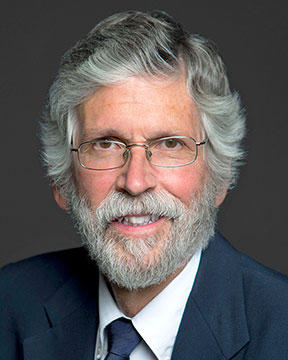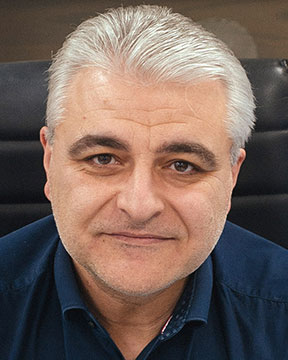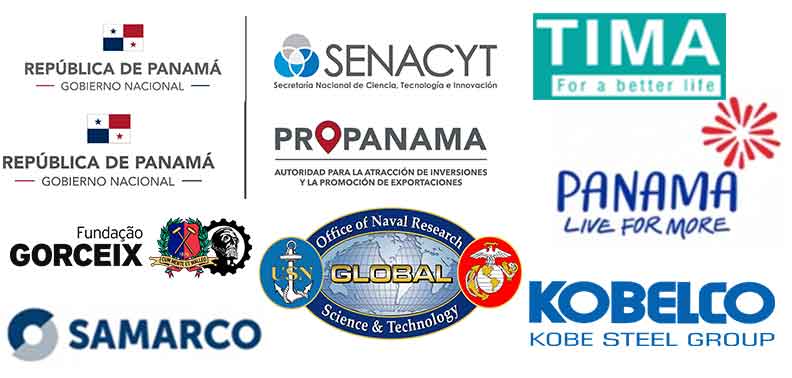























| SESSION: AdvancedMaterialsFriPM2-R5 | 7th Intl Symposium on New & Advanced Materials and Technologies for Energy, Environment, Health and Sustainable Development |
| Fri. 1 Dec. 2023 / Room: Heliconia | |
| Session Chairs: Fernand Marquis; Session Monitor: TBA | |
Today when Moore law gradually loses its effect and conventional charge-based electronics will soon come to the end development of high speed and low energy consuming information systems is urgently needed. Up to now, many new methodologies have been proposed, such as molecular electronics, nanoelectronics, spintronics, magnetronics, optronics, etc. Modern Electronics (Micro Nano Spin Electronics) and its future mainly based on novel materials (metals and nonmetals), their preparation technologies and new properties. Perfection and ultra-purity are not the only parameters characterized materials usefulness for quantum devices. Modification of material properties by different structural nonperfections (structural defects: impurities, isotopes, etc.) is the smart instrument for regulation of their characteristics. Based on difference from conventional electronics e electron’s which uses the electron’s charge degree of freedom for information processing, spintronics is devoted to incorporating the electron’s spin degree of freedom. Despite its great potential advantages, spintronics now faces a number of challenges, such as generation of fully spin-polarized carriers (pure spins) and injection of spin into devices, long distance spin transport, and manipulation and detection of carriers’ spin orientation. The solutions to these issues rely on the development of device fabrication and designing new spintronics materials with specific properties. [1]. Pure spin generation and injection mainly depends on the degree of spin polarization in the used semiconductors or metals. Thanks to the discovery of carbon based nanomaterials such as graphene [2] and carbon nanotubes, the challenge of long distance spin transport is likely to be solved in the near future. Because of their very weak spin–orbit coupling (SOC), carbon-based nanomaterials can have a long spin coherence length up to a few micrometers, thus are very good spin transportation materials. According to their electronic and magnetic properties, spintronics materials can be classified as magnetic metals, topological insulators, and magnetic semiconductors In a spintronic device, magnetic metals and topological insulators, serve as spin sources and drains, while magnetic semiconductors constitute the central region of the device.[3]. At the same time usage of electron spins as quantum bits for quantum information processing in so called quantum computers, were a qubit exists in more than one state simultaneously, is clear. Qubits in this state display a degree of correlations impossible in classical physics. This phenomenon is called entanglement and is crucial property of quantum computing. The main requirements of quantum computation are: Scalable physical systems with well characterized qubits (Zeeman Spliting); Long decoherence time: Existence of qubits at the ground state; Set of quantum gates; measurement capabilities, etc. Candidate for a qubit needs longer decoherence time than gate operation time. The transformation of digital computers from bulky machines to portable systems has been enabled by new materials and advanced processing technologies that allow ultrahigh integration of solid- state electronic switching devices. As this conventional scaling pathway has approached atomic- scale dimensions, the constituent nanomaterials increasingly possess properties that are dominated by quantum physics. [4]. The convergence between quantum materials properties and prototype quantum devices is especially apparent in the field of 2D materials, which offer a broad range of materials properties, high flexibility in fabrication pathways and the ability to form artificial states of quantum matter. Along with the quantum properties and potential of 2D materials as solid- state platforms for quantum- dot qubits, single- photon emitters, superconducting qubits and topological quantum computing elements it is necessary to select a the best method of their preparation. Potential of laser plasma process for 2D materials preparation, particularly its usefulness for organization of nanostructures applicable in spintronic and quantum computing devices novadays is actively developing. Laser plasma formed under the ionizing effect of powerful laser radiation on the thing. For example, LP arises during optical breakdown in gaseous media, laser radiation on top solid body, in laser thermonuclear targets. LP can exist in a wide range of temperatures - from 1 eV to 104 eV (104–108 K) and arising as a result of ionization of the electron impact with the subsequent image electronic avalanche, or as a result of many photon ionization. The impact of a light wave on LP leads to the formation of plasma waves (coil -ny electronic and ionic densities), which interact with the primary and scattered light. As a result, electric magnetic waves are formed with a frequency that is a multiple of the frequency of the incident light this wave (the so-called harmonics). The probability of generating high harmonics increases with an increase in intensity of laser radiation.
The properties of nanomaterials prepared by laser plasma technique are unique, and they are not reproducible by any other method including chemical ones. The usage of resonance light heat creates the opportunity to energize the selected atoms as well as their groups (assemble) and to produce plasma with the necessary properties relevant to structures which must be prepared This technique was successfully used by the authors of the project to study the conditions for obtaining diamond-like films, as well as thin layers of boron carbide. In the last two decades, the Laser plasma method was used to form both homogeneously doped GaAs:Mn layers and two-dimensional structures, including a δ-doped GaAs:Mn layer and a InxGa1 – xAs quantum well separated by a GaAs spacer with a thickness of d = 3–6 nm. It is obvious that only Mn ions, which are part of the GaMnAs solid solution and are distributed almost uniformly in it, can noticeably exchange with quantum well carriers, leading to their spin polarization and, consequently, to the anomalous Hall effect [5].. We are looking for farther development of LP processes aim of preparation the next (higher) level of spintronic nanostructures based on above mentioned and some other diluted semiconductors. Our works shown that the LP method and technology is very useful for preparation of semiconductor silicon and graphene nanosystem in one sandwich for creation of a new highly effective multiqubit element. Selection of laser sources and their parameters is giving the possibility to vary the energy of ionized atoms in plasma plum, activate them to the necessary level and deposit the hot atoms and their clusters on substrates of different origin (semiconductors: Silicon, GaAs, etc.; Metals: Fe, Ni, etc.; Insulators: Al2O3, etc). For organization of these processes it is also possible to use the resonance wavelength of the light sources in order to have the direct and strong interaction with electron’s bonding energies.
References:
[1] P. Kervalishvili. Semiconducting Nanostructures - Materials for Spintronics. Nanotechnology Perceptions, Vol. 1, N 3, 2005.
[2] K.S. Novoselov, A.K. Geim and S.V Morozov et al. Electric field effect in atomically thin carbon films. Science 2004; 306: 666–9.
[3] A. Fert, The origin, development, and future of spintronics, Nobel Lecture, December 8, 2007, Stockholm, Sweden
[4] P. Kervalishvili. Philosophy of quantum information science. NATO Science series, IOS press, v.93, 2012, 55-73.
[5] P. Kervalishvili and A. Lagutin, Nanostructures, magnetic semiconductors and spintronics, Microelectronics Journal, 39 (2008), pp.1060–1065.
| SESSION: MineralThuAM-R7 | Torem International Symposium (8th Intl. Symp. on Sustainable Mineral Processing) |
| Thu. 30 Nov. 2023 / Room: Sunflower | |
| Session Chairs: Marcos De Campos; Session Monitor: TBA | |
Bioparticles, like other biological objects, are characterized not only by different biological properties, but also purely physical. Physical parameters can be include their mass, speed of movement, mechanical, electrical, magnetic characteristics, etc. Since the biosystems like viruses travel much less than the speed of light, are small in size and mass, vibrate with a certain frequency relative to a fixed coordinate systemSpectroscopic methods have the characteristic of providing fast results and reliable information related to the composition of the samples. The studies presented have shown promising results in a field of science that needs to be better explored. It has been shown that multivariate analysis techniques are of great importance to analyze spectroscopic data, providing the potential to identify and classify biological samples.[1-3]. We do hope that with advancement in this field of study, spectroscopic methods and tools will be used in bio medicine in the nearest future. Methods of light therapy of different diseases based on estimation of EM field characteristics and resonant wave ranges based on computer simulation of nanobioparticles characterization will be widely implemented, and possibility of determination of resonant (own) frequencies of entire system of molecules including virions will be a key point for that. Recent frontiers in technology are exploring the possibility of using external excitations to vibrate a virus to its death. The genetic material of virus is DNA/RNA enclosed within the protective protein shell (Capsid). Every cell in human body has a natural tendency to vibrate at frequency known as the natural frequency, and so the virus. Natural frequency values of these vibrations are very high compared to healthy cells, and depend on the molecular structure and differ from virus to virus.In our opinion the concept and relevant methods of resonance therapy will be basis of different viral deceases treatment in the nearest future of practical medicine.
References:
[1] Kervalishvili P., Bzhalava T, Computer Simulation Study of Oscillation Mechanisms and Physical Properties of Nanosized Biostructures, Published in book: Innovative Smart Healthcare and Bio-Medical Systems, CRC Press – Taylor and Francis, New York, 2020, Chapter 6, 8 pages.
[2] Tamar Berberashvili, Paata Kervalishvili. Experimental Methods of Investigation of Vibrational Properties of Nanobioobjects. The international scientific conference: Modern research methods of bionanoagents, RMB-2021, Batumi, Georgia, 24-26 November, 2021.
[3] Kervalishvili P. Study of Vibrational Properties of Viral Particles by Computer Modeling. Egyptian Computer Science Journal Vol. 45 No.2 May 2021, pp 44-65. ISSN-1110-2586
| SESSION: MineralThuAM-R7 | Torem International Symposium (8th Intl. Symp. on Sustainable Mineral Processing) |
| Thu. 30 Nov. 2023 / Room: Sunflower | |
| Session Chairs: Marcos De Campos; Session Monitor: TBA | |
The convergence between quantum materials properties and prototype quantum devices is especially apparent in the field of 2D materials, which offer a broad range of material’s properties, high flexibility in fabrication pathways and the ability to form artificial states of quantum matter. Along with the quantum properties and potential of 2D materials as solid- state platforms for quantum- dot qubits, single- photon emitters, superconducting qubits and topological quantum computing elements it is necessary to select the best method of preparation spinqubit nanosystems [1].Leptons are fermions - particles with ½ and they are an important part of the Standard Model. Following the spin-statistics (spin-communication theorem) - theorem which states that one fermion can exist in a given quantum state and no two leptons of the same species can be in the same state at the same time lepton can have only two possible spin states - up or down. The charged lepton is the electron; the next lepton to be observed was the muon, which was classified as a meson at the time. After investigation, it was realized that the muon has not the expected properties of a meson, but rather behaved like an electron, but with higher mass. Another lepton the first neutrino, the electron neutrino, was proposed in order to explain certain characteristics of beta decay.When we are choosing the particles for quantum computing we should consider that the candidate for a qubit generally needs to have the quantum properties of superposition and entanglement. There are also the main technical requirements of quantum computation which are: scalable physical systems with well characterized qubits (Zeeman Splitting); long decoherence time higher than gate operation one; existence of qubits at the ground state; set of quantum gates; measurement capabilities, etc. Leptons – fermions (electrons, protons, neutrons, muons, tauon and even neutrinos) as we know have that kind of properties. Concerning the photons – bosons particles with frequency-dependent energy collecting into the same energy state (Bose-Einstein condensation), they also could acting as a qubits because of polarization effects they characterized.[2,3]. The usefulness the other boson particles as quantum information carriers is the very interesting task current and future research works.
References:
[1] P. Kervalishvili. Nuclear spin based model of quantum information system. Book of abstracts of International conference of Nanosensory Systems and Nanomaterials, June 6-9, 2013, EU-ISTC-GTU, Tbilisi, Georgia. 2013, p. 28-3
[2] Paata Kervalishvili. Photons, InformationTransfer and Speed of Light (Invitrd Lecture), International Conference eRA -7 The Synenergy Forum, TEIPIR, Athens, Greece, 2012.
[3] Paata J. Kervalishvili, Quantum information technology: Theory and applications. Published in: IEEE Seventh International Conference on Intelligent Computing and Information Systems (ICICIS), IEEE Xplore: 04 February 2016, DOI: 10.1109/IntelCIS.2015.7397187, Publisher: IEEE. 15p.



